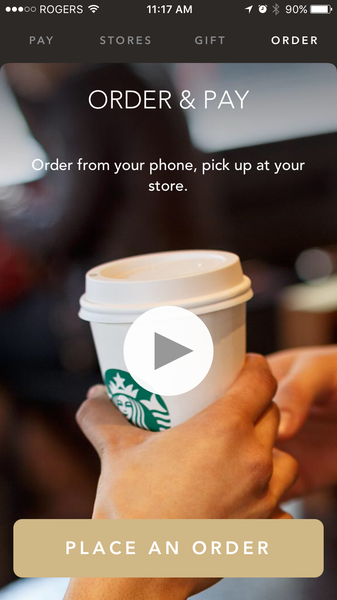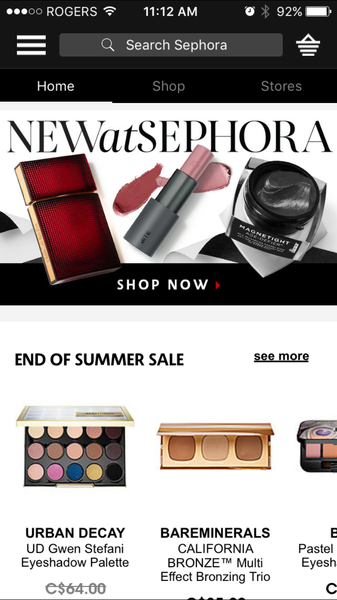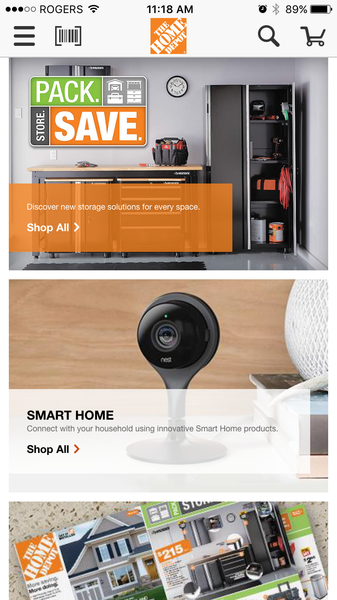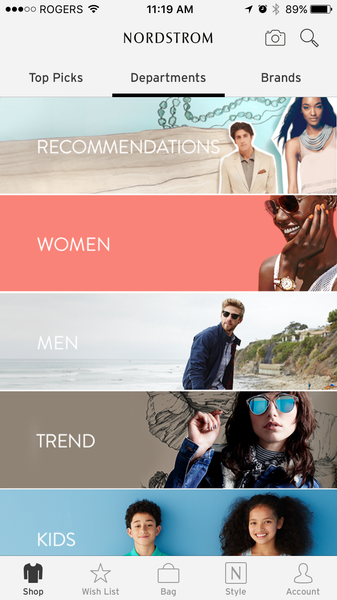In this modern age of technology, more and more shoppers are making purchases on their mobile devices — whether that be on mobile-friendly sites, apps, or in store with the assistance of information they sourced from their smartphone.
Smartphones and tablets are now an important factor in the world of retail. Recent research from IMRG and Capgemini showed that 51% of ecommerce sales in the UK between Nov. 2015 and Jan. 2016 were completed via a mobile device. A similar IBM study showed that mobile commerce accounted for 23% of sales in the U.S. in 2015.
And one of the best ways to interact with on-the-go customers is through an app. According to business intelligence firm Flurry Analytics, 90% of the time spent on a mobile device is in apps. Such data begs the question: Is a retail app right for your business?
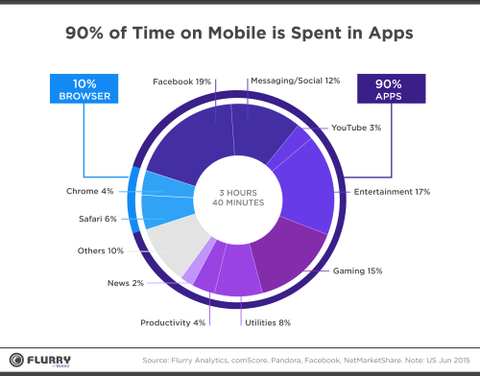
Image Credit: Flurry Analytics
Why You Should Consider a Retail App
A recent study from Aruba and Hewlett Packard Enterprise explored the relationship between customers using mobile retail apps and the more traditional brick-and-mortar shopping experience.
It's no surprise that the research showed the use of store apps is on the rise, with one in eight shoppers using a retail mobile apps 10 times a week. That's serious engagement with the digital extension of a retail brand.
🏁 How to start a business recommendations
- How to finance a small business with no money
- Small business ideas to start
- How to start a bookkeeping business
- How to get money to start a business
- How to start a business as a kid
- How to start a clothing business online
- How to start a slime business
- How to start a scrub business
- How to start a hat business
- How to start a subscription box business
The study also isolated six trends among consumers that make a pretty compelling argument for businesses of any size to consider developing a dedicated retail app. And here are some of their most cogent findings that are relevant for retailers:
1. Customers Find Retail Apps Addictive
If you’re going to invest time, money, and resources into a custom retail app for your business, you want to be sure people are actually going to use it.
Thankfully, this survey of over 500 consumers found that 86% of respondents use a retail app, and 59% use a retail app up to five times a week.
Often companies get users to download their app by offering some special deal or one-time discount, but the real return on investment comes from repeat usage over time — not to mention the invaluable customer data that app gathers. Apps are a great way to collect purchase histories, email addresses, location information, and age demographics. That kind of customer data can be gold when it comes to building out your retail marketing initiatives.
2. Smartphones Can Trump Sales Associates
Excellent customer service doesn’t solely come from sales associates. In fact, many consumers find sales associates to be too pushy or not knowledgable enough.
Trusting in their own research, many customers prefer to consult their mobile phone to check out products and reviews.
This Aruba study found that “57% of respondents would rather consult a mobile phone than a sales associate.” With this knowledge, businesses can hire and train store associates to address consumer concerns online through reviews and questions on their own site, as well as on vendor and review sites.
3. Retail Loyalty Apps Really Work
Consumers love loyalty rewards. So much so that when asked if they’d rather shop at a competitor than a store where they are already loyalty members, “less than nine percent would actually go with the competitor’s store. While 20% admitted to being indifferent to the option, a whopping 72% would select the store they were a loyalty member over other options.”
If you’re already offering a loyalty program, then a retail app is a great way for members to track their rewards, get informed about upcoming deals, and cash in their rewards for discounts or merchandise. And if you don’t currently have a loyalty program, learn how to start one to improve customer retention. Plus, a retail app can be the perfect way to launch your loyalty program to new members.
4. In-Store Navigation is Important
Mobile app usage isn’t limited to accommodating shoppers on the move. Often customers are in store looking for a blended multi-channel retail experience. Frustration arises when they’re shopping and can’t find a product they’re looking for — and it’s even worse if they can’t find an associate to help them.
Retail apps with real-time location tracking and product maps make it easier for customers to find what they’re looking for on their own.
A great example is the Walmart.com app, which allows users check in-store availability, see what aisle the product is in, and view the current price. This kind of assisted navigation was found to be a key selling feature for users surveyed in the Aruba survey. If you can offer users something that goes above and beyond the basic checkout experience, you’ll have users that are more likely to download your app.
5. The Value of In-Store Incentives
Consumers have downloaded your app and they’re in your store. How do you increase the chances of converting browsers into buyers? In-store incentives like coupons, special deals, and one-time offers make users “78% more likely to take advantage of an in-store offer if it’s presented to them.”
Even if customers aren’t physically in your store but are in the general area, beacon technology can send coupons and special promos through your app to lure them through your doors. Creating that sense of urgency gives customers that extra push to convert that they might not have otherwise made without the retail app offer.
6. WiFi is Not Optional
It’s no surprise that most customers are primarily using their mobile phones in store to connect to WiFi. Providing reliable, complimentary WiFi is key to keeping users connected to your app and using all the great features you’ve developed. Spotty connections and slow WiFi won’t do you any favors when so many customers are using their mobile phones to interact with your business.
Examples of Best-in-Class Retail Apps
Some of retail’s heavy hitters are at the forefront of mobility with retail apps that drive sales and create a seamless customer experience online and in store. Here are a few examples of retail apps to inspire you:
Starbucks
Starbucks is all about saving you time. Getting coffee should be quick and easy — after all, it’s something you do on the go with productivity in mind. The Starbucks mobile app aims to make the purchasing process as smooth as possible. And it seems to be doing just that — according to a Business Insider article about Big Data Trends in 2016, 20% of all Starbucks orders in the U.S. were made from a mobile device totaling five million orders a month.
Within the app, you can order drinks, pay instantly and pick up in store, tip your barista, earn and track Starbucks rewards, and even send gift cards to friends and family. It’s easy to check card balances and reload, so there’s no barrier to payment or frustration looking for cash.
Sephora
With massive product selection, premium products, and makeup inspiration, the Sephora app provides a bounty of information to help consumers make an informed purchase. The Sephora app allows users to scan products while they shop in store and instantly read ratings and reviews, receive mobile notifications about special offers, reorder past purchases that they loved, track points and rewards, and get inspired with tutorial videos.
And the success of Sephora’s digital strategy is undeniable. A recent Mobile Strategies 360 article summarized, “Sephora’s 2015 mobile sales were $73.6 million, which includes sales via smartphones, tablets and apps, Internet Retailer estimates. Sales via mobile devices grew 60% year over year for Sephora and now make up 26% of Sephora’s digital sales.”
Plus, with a virtual artist to digitally try on products and makeup tips and tricks, the Sephora app does loads more for customer retention and satisfaction than just sell endless tubes of mascara.
Home Depot
Renovating can be overwhelming — whether it’s gutting a home from top to bottom or making a few minor tweaks over the weekend. The Home Depot app acts as a home improvement helper and retail experience in one. Users can shop in store and online products, check availability at local stores, and even find products at their local store.
"Our customers have consistently told us [the app] makes it easier to find product in store," said Matt Jones, general manager of mobile.
Customers can also check out ideas in the “How To” center that’s loaded with home improvement tips and inspiration, scan barcodes to view product information, and save measurements in the Mobile Toolbox. And with cool built-in tools like a caliper and tape measure, who needs a real toolbox?
Nordstrom
Sleek, beautiful, and aspirational — the Nordstrom mobile app embodies every aspect of their brand. Customers can see what’s in stock at different locations, view their Nordstrom rewards, get notifications about existing orders, receive personalized recommendations, plus scan the catalogue and shop the products directly in the app.
Aiming to make the path to purchase smooth and simple, the Nordstrom retail app helps consumers research brands and styles, see what’s trending, and find their favorite items. And because the customer experience doesn’t end there, this app supports customers with after-purchase rewards tracking and order statuses to see where in the journey their items are.
Shopify Merchants
Starting to feel inspired to create your own retail app? Check out some keen Shopify merchants who have already built their own retails apps. These merchants have seen a real increase in sales with their new retail apps that they built using the Shopify Mobile Buy SDK.
How to Get Started With Your Own Retail App
Now you might be itching to build a complete ecommerce store in a mobile app. Getting started might seem daunting, but it doesn’t have to be. You have multiple options when it comes to building your own app, depending on the complexity of the features you want to include. Either way, there are tools and professionals to help, and we've rounded up a few ways you can move forward:
- Hire a Developer. If you have the bandwidth and room in your budget, it might make sense to bring someone onto your team full time. Having a developer on hand means you have more flexibility to create a custom solution, and you have someone to lean on when an app goes down or a customer discovers a bug.
- Hire an External Agency. For big app dreams, highly personalized features, and a fully branded experience, an agency might be the right fit. Check out our list of Shopify Web Developer Experts to find an agency to suit your niche and needs.
- DIY an App. While it may sound overwhelming, you can actually build your own app. No coding experience? No problem. Use a tool like ShoutEm to put together a basic branded app for iOS and/or Android for as little as $20 a month.
Look to the aforementioned examples and give our tips a try — and be sure to tell us about your results.
What are your thoughts about creating your own app? Share your ideas in the comments below.
Read more
- How Retail Store Owners Can Optimize Their Mobile Presence
- 5 Strategies to Future Proof Your Brick-and-Mortar Store
- How To Integrate Your Point of Sale With Shopify
- Lightspeed vs Shopify POS: The Best of All Lightspeed Alternatives
- Endless Aisles: How to Run a Low Inventory Store and Keep Up with Demand




